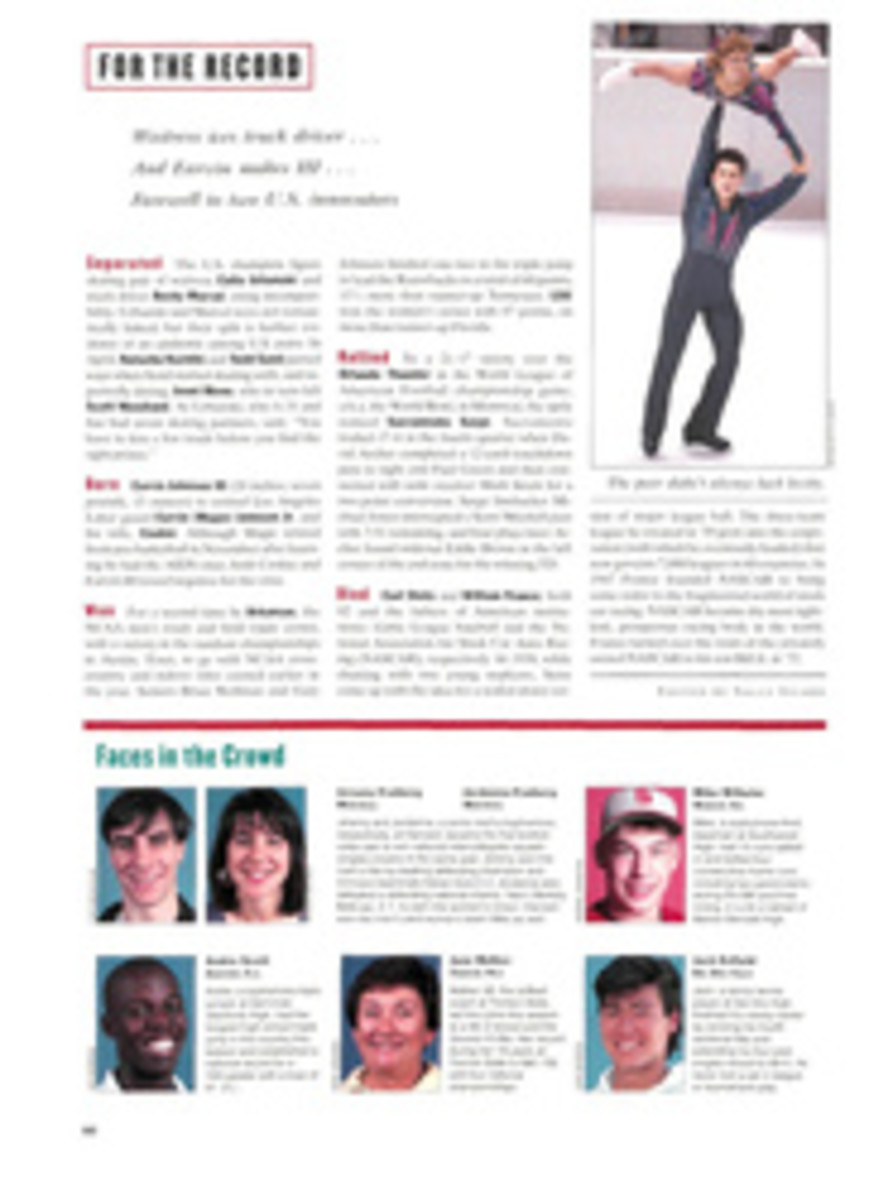
Strictly for the Birders
Each year after school ends, the boys and girls of summer head for sports camps of every kind: baseball, tennis, golf, sailing. Week after week, they strive to master the curveball or the forehand smash or the chip shot or the jibe under the tutelage of master players and coaches.
But for some, whose fields of dreams happen to have birds in them, the difference between a rufous-crowned sparrow and a cactus wren is far more exciting than debating the merits of the squeeze bunt versus the sacrifice fly. With binoculars and field guides in hand, these enthusiasts migrate to Camp Chiricahua—150 miles southeast of Tucson.
Founded in 1986 by Victor Emanuel, a noted ornithologist whose Victor Emanuel Nature Tours are taken by thousands of adult birders each year, Camp Chiricahua offers a single two-week session each summer. Youngsters ages 11 to 17 learn birding under the wing of such masters as Roger Tory Peterson, Kenn Kaufman and Emanuel himself.
Birding, as Emanuel sees it, is the hobby of a lifetime. "Most athletes can remain active in a sport for just a few years," Emanuel points out. "Birding is forever."
Arriving in Tucson on the way to the Chiricahua Mountains, 15 boys and girls are eager to begin their two weeks of intensive birding in an area considered to be one of the best habitats in the world for many species. Flying in from East Lansing, Mich., Dan Chiaravalli and Dan Smyth, both 14, step off the airplane with their binoculars, or " 'nocs," raised and immediately scan the blue Arizona sky. "We're really psyched!" Chiaravalli says. For them, the chance to bird with others their age is a rare treat.
"Most young people don't have much interest in birds," Emanuel says. "If you're the only kid in your school who likes to watch birds, you'll lead a lonely life."
"I don't know too many other kids interested in birding where I'm from," says Cooper Scollan, 14, from Carmel, Calif. Matt Weiss, 13, from Miami, agrees. "I know I'm not supposed to let their joking get to me," he says, "but it does."
At Camp Chiricahua, young birders meet others who share an interest in the sport and discover they aren't alone. "I want them to have confidence in birding as a joyful and exciting sport," Emanuel says.
The campers awake at 5:30 a.m. "We get up with the birds," one inevitably says. Jeff Kitchens, 15, from Arlington, Va., announces that he sees the silhouette of a black cardinal. "A juvenile," he insists. Bob Drewes, a camp counselor from San Francisco who teaches herpetology at the California Academy of Sciences, is skeptical. "There's no such thing," Drewes says. Jeff holds his ground. The argument finally engages Peterson, who is probably the best-known birder in the world. Peterson smiles benignly. He supports the kids' camp as the best thing that has happened to birding since he published his first field guide, in 1934. "Maybe it's a Phainopepla," Peterson suggests, naming a shiny black insect-eater. The "black cardinal" returns, this time in good light, balancing easily on an Apache pine limb, resplendent in a coat of gray and rose. "Pyrrhuloxia!" exclaims Emanuel, "the western version of a cardinal." Though wrong about the bird, Jeff beams. "That's a lifer for me," he says with a grin.
All birders keep running life lists of the birds they've seen. With the devotion of baseball buffs recording base hits and runs batted in, the campers note the species they've seen and where and when they were spotted. At night, field notes are transferred to life-list books. At 10 p.m., counselor Barry Lyons, a political science student at the University of Arizona, has to make Dan Smyth stop working on his list and go to bed.
Jeff, with wide-eyed wonder, announces that he has added 10 birds to his life list in one day, bringing it to 254. Matt adds eight birds to a life list of 230. At noon the next day, David Paleias, 15, from New York City, and Brian O'Shea, 15, from Chicago, can't wait until evening to spread out their field notes and begin transferring field sightings to their life lists: Avocet? Check. Cinnamon teal? Check. Brian's list stands at 388. "I like lists," he says.
Emanuel calls a meeting after everyone has arrived. "This is not a tour," he tells the campers. "It is an educational adventure. Campers will learn to identify birds, understand their life zones, and appreciate the environmental role that birds play in nature. There's no birder who is not also an environmentalist in the best sense of the word. That's someone who cares about the world we live in and tries not to harm it." Emanuel offers a quote: " 'Nature is the art of God,' " and he tells his campers to "share the work, look after each other, and behave yourselves." Individualists all, pursuing the unusual in a world that discourages nonconformity, the campers nevertheless look as alike as hens' eggs. The uniform of the day is baggy shorts, knee-length T-shirt emblazoned with psychedelic colors, hightop athletic shoes and baseball cap. Even Drewes's daughters, Jilly and Cait, who are 11 and 13, respectively, wear similar unisex garb. Backpacks hold field guides, notebooks and candy bars. From every neck dangles a pair of 'nocs, the sine qua non of the birding fraternity.
One field trip takes the campers south of Tucson, out through rocky hills populated by the elegant saguaro cactus and its teddy-bear-like relative, the cholla.
"I hope we see a roadrunner," Jeff says wistfully. Matt wants an elf owl. Dorian Anderson, 12, from Philadelphia, yearns for a scaled quail. Cait points out a coyote barely visible in the dusty brush. Coyotes are judged to be cool, but they aren't birds. Moments later, Emanuel stops the van he's driving as a roadrunner trots across the road and pauses in a dry wash.
"Thank you, god!" Jeff cries. Someone adds, "We've seen Wile E. Coyote and the Road Runner. Now if Bugs Bunny shows up, I'm outta this theme park."
A Harris's hawk perched on a telephone pole draws a crowd. Fledgling birders vacate the two vans, binoculars poised. Dan Chiaravalli struggles out with a 20 X 60 KOWA spotting scope on a tripod mount. "I spent all my savings on it," he says. He extends the legs, removes the cover and sights the scope—only to find the bird has flown. In deep exasperation, he says to Peterson, "By the time I get ready, it's all over with." From the perspective of his 82 years, Peterson says, "That's the way life is."
The campers arrive at Cave Creek Canyon in the Chiricahuas, which soar close to 7,000 feet above the desert. More than 100 species, and all manner of birders, flock to these mountains.
Eight of North America's 16 species of hummingbirds migrate to southeastern Arizona in the spring and summer to mate, nest and fledge their bee-sized chicks before returning south to beat the onslaught of winter. Scores of dedicated birders have built summer homes in the canyon, where hummingbird watching is a major occupation. The campers join adults seated on lawn chairs and benches that are ranged in rows alongside feeders dangling from a clothesline. Six species of hummingbirds are hovering, sipping sugar water. In hushed tones reminiscent of Wimbledon or Pebble Beach, the campers express their excitement.
"Look! A lucifer!"
"Splendid! Just splendid!"
"The purple gorget! Did you see it?"
"Bright as neon!"
"Watch the broad-tailed go after him!"
"What a battler!"
The tiny birds parry and riposte like fencers, their wings beating too fast for human eyes to follow, before darting away. One amateur ornithologist reports that she has banded 6,000 hummingbirds in five years of working with them.
After parking at a campsite, the campers hike up Cave Creek Canyon, its floor bathed in the yellow light reflected from the towering rhyolite spires aptly named the Cathedral Rocks. They scan the sycamores and Arizona pines for the flash of red and green that signals the presence of a rare elegant trogon. The bird's guttural call has announced its presence, but it remains hidden in the gathering shadows.
Back at camp, Kerry Joseph discovers that life in New York City hasn't prepared his 12-year-old legs for hours of hiking over rough mountain paths. "I'm worn out," he tells Peterson. "Aren't you?"
The Babe Ruth of American birding smiles. "You gotta keep moving, son," he says, "or they'll throw you in a hole."
PHOTO
EDWARD MCCAIN
Peterson (center) and Emanuel (to his left) offer expertise.
PHOTO
BOB AND CLARA CALHOUN/BRUCE COLEMAN
In the summertime Arizona is a hummingbird hotbed.
PHOTO
RALPH A. REINHOLD/ANIMALS, ANIMALS
This avocet may be added to some lists.
PHOTO
TED LEVIN/ANIMALS, ANIMALS
Binoculars bring the avian quarry up close. Here, a male cardinal perches on a saguaro.
Downs Matthews is a free-lance writer and editor who lives in Houston.

